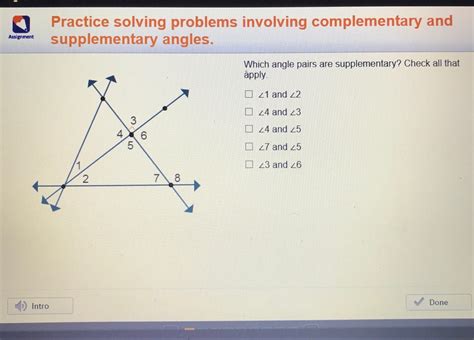Angles play a crucial role in geometry and trigonometry, and understanding their relationships is fundamental to solving various mathematical problems. Whether you’re a student struggling with geometry homework or a professional working with angles regularly, having a reliable tool to determine angle relationships can be immensely helpful.
1. Complementary Angles
Complementary angles are two angles that add up to 90 degrees. To find the complement of an angle, subtract its measure from 90 degrees. For example, if angle A measures 30 degrees, the complement of angle A would be 90 – 30 = 60 degrees.
2. Supplementary Angles
Supplementary angles are two angles that add up to 180 degrees. To find the supplement of an angle, subtract its measure from 180 degrees. For instance, if angle B measures 120 degrees, the supplement of angle B would be 180 – 120 = 60 degrees.
3. Adjacent Angles
Adjacent angles are two angles that share a common vertex and a common side, but do not overlap. In other words, they are side-by-side angles. Adjacent angles can be added together to find the total angle measure around a point, which is always 360 degrees.
4. Vertical Angles
Vertical angles are formed by two intersecting lines and are opposite each other. They have equal measures. Suppose angle C measures 40 degrees; then the vertical angle opposite angle C would also measure 40 degrees.
5. Corresponding Angles
Corresponding angles are formed when a transversal intersects two parallel lines. They lie on the same side of the transversal and in corresponding positions. Corresponding angles have equal measures. For example, if angle D measures 60 degrees, the corresponding angle on the other parallel line will also measure 60 degrees.
6. Conclusion
An angle relationships calculator can be immensely valuable in quickly determining the relationships between angles. By incorporating the formulas and rules mentioned above, you can easily find complementary, supplementary, adjacent, vertical, and corresponding angles. Whether you’re solving geometry problems or working on real-world applications, having a reliable calculator at your disposal saves time and minimizes the chance of errors.
Leave a Comment
We hope you found this blog post on angle relationships calculator helpful. If you have any questions, suggestions, or additional insights, please leave a comment below. We’d love to hear from you!
Line And Angle Relationships Calculator
Line And Angle Relationships Calculator In the world of mathematics understanding line and angle relationships is crucial. These relationships not only help us solve complex problems but also play a fundamental role in various disciplines such as engineering architecture and physics. However calcula – drawspaces.com

Angle Relationships With Parallel Lines Calculator
Angle Relationships With Parallel Lines Calculator Understanding angle relationships with parallel lines is an essential aspect of geometry. However calculating these angles manually can be time-consuming and prone to errors. Fortunately with the help of modern technology we now have access to angle – drawspaces.com

Triangle Calculator
This free triangle calculator computes the edges, angles, area, height, perimeter, median, as well as other values and a diagram of the resulting triangle. – www.calculator.net
Angle calculator for angles as used in the Nautical Almanac – Math …
Nautical angle calculator. This calculator is used to add and subtract angles in … Angle relationships. Vertical angles · Complementary angles · Supplementary … – www.mathopenref.com
Complementary and Supplementary Angles Calculator
Complementary and Supplementary Angles Calculator: This calculator determines the complementary and supplementary angle of a given angle that you enter OR … – www.mathcelebrity.com

Supplementary Angle Calculator – Free online Calculator
Supplementary angle calculator. Learn how to use the supplementary angle calculator with the step-by-step procedure. Get the supplementary angle calculator … – byjus.com

Angles Calculator – Symbolab
Free Pre-Algebra, Algebra, Trigonometry, Calculus, Geometry, Statistics and Chemistry calculators step-by-step. – www.symbolab.com

Transversal Angle Calculator
Transversal Angle Calculator: Simplify Angle Measurements with Ease In the world of geometry understanding and calculating angles is essential for solving complex problems and real-world applications. One key aspect of this is transversal angles which play a crucial role in various scenarios. In thi – drawspaces.com

Transversal Of Parallel Lines Find Angle Measures Calculator
Transversal Of Parallel Lines Find Angle Measures Calculator Welcome to our comprehensive blog post on the topic of finding angle measures using a transversal of parallel lines calculator. Understanding the concept of transversals and parallel lines is crucial in geometry and this calculator will he – drawspaces.com

Corresponding Angle Calculator
Corresponding Angle Calculator: Simplify Angle Relationships with Ease Angles play a fundamental role in geometry engineering and various other disciplines. Understanding the relationships between angles is crucial for solving complex problems and gaining a deeper comprehension of spatial concepts. – drawspaces.com

Triangle Angle Calculator – CalcTree
Jul 6, 2023 … Need to calculate triangle angles? Look no further than CalcTree. Free-To-Use Triangle Angle Calculation tool. Try it now. – app.calctree.com

Supplementary Angles Calculator
Nov 20, 2023 … Supplementary angles relationships. Welcome to the supplementary angle calculator. You don’t need to rack your brain on how to find … – www.omnicalculator.com

Vertical Angles Relationship | Desmos
Explore math with our beautiful, free online graphing calculator. Graph functions, plot points, visualize algebraic equations, add sliders, animate graphs, … – www.desmos.com

Compressible Aerodynamics Calculator
Conical Shock Relations Perfect Gas, Gamma = , angles in degrees. INPUT: M1 = Cone angle, Wave angle, Mc. = Mc= – devenport.aoe.vt.edu
Solve for X Calculator – eMathHelp
The calculator will try to find the x (exact and numerical, real and complex) in the given equation. – www.emathhelp.net